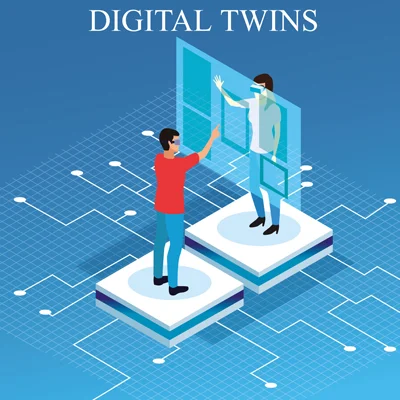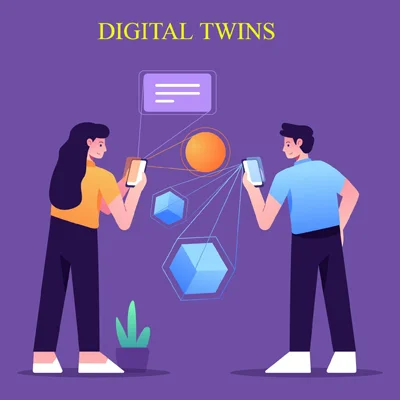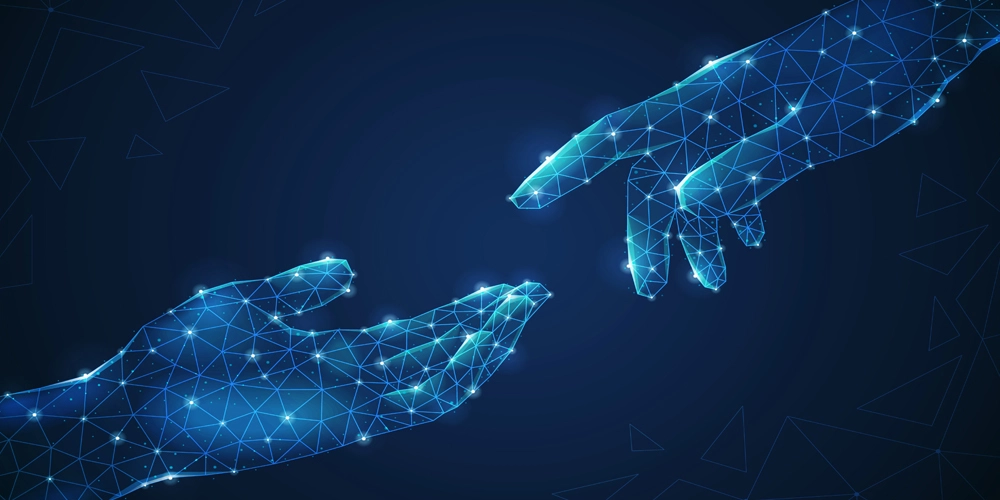Digital Twins: Response Preparing For The Unpredictable, is a virtual representation of a physical object, system, or process. It is created using digital data and models to simulate the real-world counterpart, providing a means to monitor, analyze, and make decisions about the physical entity in a digital environment. Digital twins are often used in various fields, including manufacturing, healthcare, urban planning, and more. They can range from simple 3D models to complex, data-rich simulations, and are employed to enhance understanding, improve performance, and optimize processes. Digital twins have become an essential tool in the era of the Internet of Things (IoT) and are used for predictive maintenance, design optimization, and real-time monitoring, among other applications.
History of Digital Twins
The concept of digital twins has evolved over time, and its history is closely tied to advancements in technology, particularly in the fields of manufacturing, aerospace, and engineering.
Here is a brief overview of the history of digital twins:
- Early Conceptual Roots (1960s-2000s): The idea of creating digital representations of physical systems and processes has roots dating back to the 1960s and 1970s. However, the term “digital twin” itself was coined in the early 2000s. NASA is often credited with pioneering early work on digital twins in the context of space missions.
- Aerospace and NASA (2002): NASA used the term “digital twin” in a presentation in 2002. They utilized digital twins to create virtual models of spacecraft and satellites. These digital twins allowed them to simulate and analyze mission scenarios, test designs, and monitor equipment remotely.
- Manufacturing and Industry 4.0 (2010s): The concept gained momentum with the rise of Industry 4.0 and the Internet of Things (IoT). In the manufacturing sector, digital twins were increasingly used to model and optimize factory processes, track equipment performance, and improve overall efficiency.
- IoT and Smart Cities (2010s): Digital twins found applications in the development of smart cities and urban planning. Cities began to create digital replicas of infrastructure, transportation systems, and public services to enhance decision-making and urban development.
- Healthcare (2010s): Digital twins have been applied in healthcare, particularly in personalized medicine. These twins are used to create virtual models of patients, helping to individualize treatment plans and improve medical outcomes.
- Growth in Industrial Sectors (2010s-2020s): Industries such as automotive, energy, and construction embraced digital twin technology to monitor assets, predict maintenance needs, and optimize operations. Real-time monitoring and analytics played a crucial role in these applications.
- Expanding Technology and AI (2020s and Beyond): Advances in artificial intelligence, machine learning, and the growing availability of data from IoT sensors have made digital twins even more powerful and versatile. They are increasingly used for predictive analytics, automation, and improving decision-making processes.
The history of digital twins reflects the growing integration of digital technology and the physical world. As technology continues to advance, digital twins are likely to play an increasingly significant role in various industries, supporting decision-making, optimizing processes, and improving efficiency.

Types of Digital Twins
Digital twins come in various types, each tailored to specific applications and industries.
Here are some of the key types of digital twins:
- Product Digital Twins:
– Product digital twins are virtual representations of physical products or components. They are used in product design, development, and testing.
– Applications include design optimization, prototyping, and simulating product behavior under different conditions. - Process Digital Twins:
– Process digital twins replicate real-world manufacturing or operational processes. They can be used to model and optimize production lines, supply chains, and other processes.
– Applications include process optimization, predictive maintenance, and quality control. - System Digital Twins:
– System digital twins model complex systems or environments, such as smart cities or large-scale infrastructure. They can provide a holistic view of various interconnected components.
– Applications include urban planning, traffic management, and environmental monitoring. - Healthcare Digital Twins:
– Healthcare digital twins create virtual representations of patients, including their physiological and medical data. These are used for personalized medicine, treatment planning, and medical research.
– Applications include treatment optimization, drug discovery, and disease modeling. - Asset Digital Twins:
– Asset digital twins are focused on monitoring and maintaining physical assets, such as industrial machinery or infrastructure. They provide real-time data about asset health and performance.
– Applications include predictive maintenance, asset management, and lifecycle analysis. - City Digital Twins:
– City digital twins replicate urban environments, including buildings, transportation systems, utilities, and more. They are used for urban planning and management.
– Applications include city planning, traffic management, and disaster response. - Environmental Digital Twins:
– Environmental digital twins simulate natural ecosystems or geographical areas. They are used for environmental monitoring and conservation efforts.
– Applications include environmental impact assessments, conservation planning, and disaster prediction. - Human Digital Twins:
– Human digital twins create virtual representations of individuals or groups of people. They are used in areas like sports, fashion, and personalized services.
– Applications include personalized fitness programs, clothing design, and entertainment. - Energy Digital Twins:
– Energy digital twins model energy systems, such as power plants, grids, and renewable energy installations. They help optimize energy production and distribution.
– Applications include energy management, grid optimization, and renewable energy integration. - Cognitive Digital Twins:
– Cognitive digital twins incorporate artificial intelligence and machine learning to simulate and predict the behavior of complex systems, such as financial markets, weather patterns, or social networks.
– Applications include financial modeling, weather prediction, and social behavior analysis.
These are just a few examples of the diverse types of digital twins, and new applications continue to emerge as technology evolves. Digital twins provide a powerful framework for simulating and analyzing the physical world, enhancing decision-making, and improving efficiency in various industries.
Facts of Digital Twins
Digital twins are a fascinating and rapidly evolving technology with many interesting facts.
Here are some notable facts about digital twins:
- Origin in Space Exploration: The term “digital twin” was first coined and used by NASA in the early 2000s for modeling and simulating space missions.
- IoT and Data-Driven: Digital twins are closely linked to the Internet of Things (IoT) as they rely on real-time data from sensors and devices to create accurate virtual representations of physical objects and systems.
- Advancements in Artificial Intelligence: The increasing use of artificial intelligence (AI) and machine learning technologies has greatly enhanced the capabilities of digital twins for predictive analytics and autonomous decision-making.
- Diverse Applications: Digital twins have applications in numerous industries, including manufacturing, healthcare, transportation, urban planning, energy, and environmental conservation.
- Predictive Maintenance: In manufacturing and asset management, digital twins are used for predictive maintenance, allowing organizations to schedule repairs and replacements before equipment failures occur.
- City Planning and Smart Cities: Digital twins play a crucial role in smart city initiatives by modeling urban environments, traffic patterns, and utility systems to optimize city operations and enhance quality of life.
- Complex System Modeling: They are capable of simulating and monitoring complex systems, including supply chains, ecosystems, and financial markets.
- Healthcare Personalization: In healthcare, digital twins help create personalized treatment plans and improve patient outcomes by modeling the health status and unique characteristics of individual patients.
- Reducing Environmental Impact: Environmental digital twins aid in the conservation of natural resources, management of biodiversity, and reduction of pollution.
- Evolving Technology: The technology is continually advancing, with an increasing focus on real-time simulations and the integration of data from multiple sources, including AI, 5G connectivity, and augmented reality (AR).
- Combining with Augmented Reality: Digital twins are being integrated with augmented reality to enable technicians and engineers to interact with and troubleshoot physical systems more effectively.
- Data Security and Privacy: With the vast amount of data required for digital twins, data security and privacy concerns are significant. Protecting sensitive information and ensuring data integrity are top priorities.
- NASA’s Digital Earth: NASA’s Earth Science Division has been working on creating a “Digital Earth” by integrating digital twins of Earth’s various systems, including the atmosphere, oceans, and land, to better understand and predict environmental changes.
- Economic Impact: Digital twins have the potential to generate significant economic benefits by improving efficiency, reducing downtime, and enabling more informed decision-making.
- Interconnected Ecosystems: As the Internet of Things and digital twins become more widespread, we are entering an era where entire ecosystems, including smart cities, transportation networks, and industrial complexes, are connected and simulated in digital space.
Digital twins represent a transformative technology that holds great promise for improving processes, decision-making, and problem-solving across a wide range of industries and applications.
Benefits of Digital Twins
Digital twins offer a wide range of benefits across various industries and applications. These benefits stem from their ability to create virtual representations of physical objects, systems, and processes and use real-time data to simulate and analyze their behavior.
Here are some of the key advantages of digital twins:
- Improved Decision-Making:
– Digital twins provide a holistic view of physical assets or systems, enabling better-informed decision-making. Real-time data and simulations help stakeholders make data-driven choices. - Predictive Maintenance:
– They can forecast equipment failures and maintenance needs by monitoring the real-time condition of physical assets, reducing downtime and repair costs. - Efficiency and Optimization:
– Digital twins help optimize processes, whether in manufacturing, logistics, or urban planning. This can lead to increased efficiency and cost savings. - Reduced Downtime:
– By predicting maintenance needs and identifying issues early, digital twins can reduce unexpected downtime, especially in industries like manufacturing and transportation. - Product Design and Prototyping:
– They enable virtual testing and prototyping of products and systems, reducing the need for physical prototypes and speeding up the design process. - Personalized Medicine:
– In healthcare, digital twins create patient-specific models for personalized treatment and drug development. - Urban Planning and Smart Cities:
– City digital twins help plan and manage urban infrastructure, transportation, and utilities, resulting in more efficient and sustainable cities. - Environmental Impact Reduction:
– Environmental digital twins assist in managing natural resources, conserving ecosystems, and reducing pollution. - Risk Mitigation:
– They can simulate and assess risks in various scenarios, helping organizations plan for and mitigate potential issues. - Supply Chain Optimization:
– Digital twins can monitor and optimize supply chain operations, reducing costs and enhancing responsiveness. - Energy Management:
– Energy digital twins help optimize the generation and distribution of energy, increasing efficiency and reducing waste. - Health and Safety:
– They can be used to monitor and enhance health and safety in various environments, such as factories or construction sites. - Data-Driven Insights:
– Real-time data collection and analysis through digital twins offer valuable insights into various aspects of a system, which can lead to process improvements and innovation. - Quality Control:
– They assist in ensuring the quality and consistency of products and services through real-time monitoring and feedback. - Collaboration and Communication:
– Digital twins facilitate communication and collaboration among teams, departments, and organizations, leading to better coordination and problem-solving. - Education and Training:
– They provide valuable tools for training and education in various fields, enabling simulations and hands-on experience without physical risk. - Optimal Resource Allocation:
– Digital twins help allocate resources effectively and efficiently, reducing waste and improving resource utilization. - Sustainability:
– By optimizing processes and resource usage, digital twins can contribute to sustainability efforts and environmental conservation.
The benefits of digital twins are diverse and continue to evolve as technology advances. They have the potential to transform industries and improve the way we design, operate, and manage systems and processes.

What is the scope of digital twins?
The scope of digital twins is vast and continually expanding as the technology evolves. Digital twins have the potential to impact various industries and applications, offering new possibilities for improving processes, decision-making, and efficiency.
Here is an overview of the scope of digital twins:
- Manufacturing and Industry: Digital twins are extensively used in manufacturing for process optimization, quality control, and predictive maintenance. They offer a comprehensive view of production lines and machinery, leading to increased efficiency and reduced downtime.
- Aerospace and Defense: Aerospace companies employ digital twins to simulate and analyze aircraft and spacecraft behavior. This helps in design optimization, performance monitoring, and predictive maintenance.
- Healthcare and Medicine: Digital twins have applications in personalized medicine, allowing the creation of patient-specific models for treatment planning, drug development, and disease prediction.
- Energy and Utilities: In the energy sector, digital twins help optimize the operation and maintenance of power plants, grids, and renewable energy installations, leading to better resource management and sustainability.
- Smart Cities and Urban Planning: City digital twins support urban planning and management, enabling better traffic management, infrastructure development, and public service optimization.
- Transportation and Logistics: They improve the efficiency and safety of transportation systems by monitoring vehicles and infrastructure. This includes predictive maintenance for public transit and logistics optimization.
- Environmental Conservation: Digital twins are used to manage ecosystems, monitor wildlife, and analyze environmental data, contributing to biodiversity conservation and sustainable resource management.
- Supply Chain and Logistics: They optimize the supply chain by monitoring assets, inventory, and delivery routes, reducing costs and enhancing responsiveness.
- Building and Construction: Digital twins assist in the construction industry by simulating building projects, enabling design validation, and enhancing project management.
- Oil and Gas: The oil and gas industry uses digital twins for monitoring and maintenance of drilling rigs, pipelines, and refineries. They help improve safety and efficiency.
- Education and Training: Digital twins provide valuable tools for training and education in various fields, enabling realistic simulations and hands-on experience.
- Entertainment and Gaming: Digital twins are used in the gaming industry for creating realistic avatars and characters, enhancing the gaming experience.
- IoT and Data Analytics: They play a crucial role in the Internet of Things (IoT) by collecting and analyzing real-time data from various IoT devices, leading to better decision-making.
- Finance and Risk Analysis: In the financial sector, digital twins are used for risk analysis, financial modeling, and investment strategies.
- Fashion and Design: They assist in the fashion and design industry by creating virtual prototypes and allowing designers to experiment with various designs.
The scope of digital twins continues to expand as technology advances, and new applications emerge. With the integration of artificial intelligence, machine learning, augmented reality, and 5G connectivity, digital twins are becoming more powerful and versatile, offering innovative solutions for various industries and domains.
Does digital twin use artificial intelligence?
Yes, digital twins often incorporate artificial intelligence (AI) and machine learning technologies to enhance their capabilities and provide more advanced and dynamic simulations.
AI is an essential component of many digital twin systems, and it plays several critical roles:
- Real-Time Data Analysis: Digital twins rely on real-time data from sensors and IoT devices to create accurate virtual representations of physical objects or systems. AI is used to analyze and interpret this data, enabling the digital twin to mimic the behavior of its physical counterpart.
- Predictive Analytics: AI algorithms are employed to predict and identify trends, patterns, and anomalies in the data collected from the physical system. This helps in forecasting maintenance needs, potential issues, and performance improvements.
- Anomaly Detection: AI models can detect deviations from expected behaviors in real-time data. When anomalies are identified, notifications can be sent, and corrective actions can be initiated, reducing the risk of equipment failure or other issues.
- Optimization: Machine learning algorithms can optimize processes and system parameters within the digital twin, helping to find the most efficient configurations and solutions.
- Simulations and Scenarios: AI-driven simulations can model various scenarios and what-if situations, allowing users to evaluate different options and their potential outcomes.
- Natural Language Processing (NLP): Some digital twins use NLP and AI to enable natural language communication with the virtual representation, making it easier for users to interact with and retrieve information from the twin.
- Autonomous Decision-Making: In some cases, digital twins are designed to make autonomous decisions based on the data they collect and the AI models they employ. For example, in an industrial setting, a digital twin might automatically adjust equipment settings to optimize production efficiency.
- Deep Learning: Deep learning techniques, a subset of machine learning, can be used for complex pattern recognition and analysis within digital twin systems, particularly in scenarios where data is high-dimensional and requires sophisticated processing.
- Continuous Learning: AI models within digital twins can adapt and improve over time as they gather more data, making them more accurate and effective at simulating and analyzing real-world systems.
The integration of AI in digital twins is particularly valuable for applications where real-time data analysis, predictive maintenance, and decision-making are essential. It allows digital twins to evolve beyond static models into dynamic, self-learning systems that provide actionable insights and contribute to improved performance and efficiency in various industries.
Internet of Things: (IoT) Benefits & Building The Urban Future





